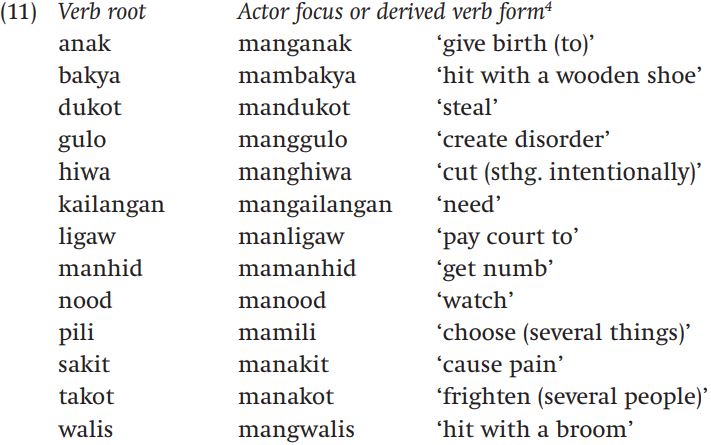


 Grammar
Grammar
 Tenses
Tenses
 Present
Present
 Past
Past
 Future
Future
 Parts Of Speech
Parts Of Speech
 Nouns
Nouns
 Verbs
Verbs
 Adverbs
Adverbs
 Adjectives
Adjectives
 Pronouns
Pronouns
 Pre Position
Pre Position
 Preposition by function
Preposition by function 
 Preposition by construction
Preposition by construction
 Conjunctions
Conjunctions
 Interjections
Interjections
 Grammar Rules
Grammar Rules
 Linguistics
Linguistics
 Semantics
Semantics
 Pragmatics
Pragmatics
 Reading Comprehension
Reading Comprehension|
Read More
Date: 2024-02-10
Date: 2023-08-17
Date: 19-1-2022
|
So far we’ve looked at allomorphy in English and a couple of other languages. In this section, we’ll take a close look at another language and see how morphologists go about analyzing allomorphy in a language that’s unfamiliar. Take a look at the data in (11) from the Philippine language Tagalog (Schachter and Otanes 1972: 290–1):

The first thing that should leap out at you when you see these data is that the forms in the right-hand column (let’s refer to them as the derived forms) seem to have some sort of prefix. But it’s not always exactly the same prefix. The prefix looks like mang- in the first form, mam- in the second, and man- in the third. There’s clearly some allomorphy displayed in this set of data.
To see better what’s going on, it is often a good strategy to rearrange the data so that similar forms are put together. This allows you to begin to see patterns. There are a number of ways of doing this, but in (12), I’ve rearranged them into four groups. In the first, we can clearly segment off the prefix mang-. In the second group, it’s still possible to segment off a prefix and leave behind something that looks exactly like the verb root. What’s left over is either mam- or man-. The examples in (12c) look like something is missing, though. If we were just putting together a prefix with the stem, we might expect mammanhid and mannood, rather than the forms we actually find. And finally in (12d), we have forms in which the initial consonant of the verb root clearly seems to be absent.

Let’s start with the forms in (12a) and (12b) that are easily segmentable. Segmenting the derived verbs, we find the allomorphs mam-, man- and mang-. The first occurs on a root beginning with [b], the second with roots beginning with [d] and [l], and the third with roots beginning with [ʔ], [g], [h], or [w]. This far, the data should not surprise you: Tagalog seems to have a process of nasal assimilation, just as English and Zoque do. The labialfinal allomorph mam- occurs with a labial consonant, the alveolar-final allomorph man- occurs with alveolar initial roots, and the velar-final allomorph mang- occurs with roots that begin with either velar or glottal consonants. So far, things seem fairly neat.
When we turn our attention to the data set in (12c), however, we will see that there’s more to be said about the derived forms of the verb. It’s not so clear how to segment the forms in this set. Suppose we assume that the prefix is mam- or man-, as it was in (12a, b); we are then left with anhid or ood as allomorphs of the roots. Alternatively, we might assume that the prefix in these cases is just ma-. If we do so, then the bases would be exactly the same as the roots, namely manhid and nood. This might seem like the best solution at the moment – just adding another allomorph to the set we already have of mang-, man-, and mam-, but let’s keep our minds open to both solutions until we’ve finished looking at all the data.
The data in (12d) present us with a new problem. If we assume that Tagalog has nasal assimilation, we would expect that we would put together mam- with pili to get mampili and man- with takot to form mantakot, and so on. But instead we get mamili and manakot. The initial consonant of the stem seems to disappear when the prefix is attached. Now, if we look back and compare the verb roots that we find in (12b) and compare them to those we find in (12d), we will see that the former begin with voiced labial or alveolar consonants, whereas those in (12d) begin with voiceless consonants. It looks like when the prefix attaches to a base that begins with a voiceless consonant, the prefix first assimilates to the point of articulation of the following voiceless consonant, and then that consonant disappears.
Here, we need to stop and think more about the nasal assimilation rule. I suggested that each set of allomorphs has a single underlying form, from which the others are derived by phonological rule. Since nasal assimilation in Tagalog seems to be a predictable process, we would assume this to be the case here as well. So we need to decide at this point what the underlying form should be. Remember that it’s often a good strategy to pick as the underlying form the allomorph that has the widest distribution, in other words the one that occurs with the most classes of sounds. Here, as the data in (12) show, the allomorph mang- occurs with glottal initial roots ([h] and [ʔ]), as well as with velars ([g], [k], [w]). The allomorph mam- occurs only with labial-initial roots ([p],[b]), and the man- allomorph only with alveolar-initial roots ([d], [t], [l]). We can reasonably make the hypothesis then that the underlying form of the prefix is mang-, since it occurs with two different classes of sounds. If so, then the forms in (12) have the following underlying representations:

Now we can give an informal statement of two phonological rules that will derive the allomorphs from the underlying forms:

For the forms in (12a), neither rule applies. For those in (12b), only the first applies, since the verb roots don’t begin with voiceless consonants. But in (12d) both rules apply.

What about the examples in (12c), however? Remember that we were undecided as to whether the allomorph of the prefix should end in a nasal at all, and we were leaning towards the solution in which the allomorph was ma-, as it would allow us to say that the verb roots always had the same form. We can see now, however, that that might not be the right solution. Suppose that we were to assume that the correct allomorph is ma-; since we have postulated that the underlying version of the prefix is mang-, we would have to derive ma- from underlying mang-. This in turn would require us to add a third rule that would delete -ng before a nasalinitial verb root:

Before we add this third rule, however, let’s see what happens if we assume that for these bases the allomorphs for the prefix are mam- or man-. Note that we already have an assimilation rule that accounts for which of the allomorphs shows up – we get mam- before an m- initial root, and man- before an n- initial root. And we already have a rule that deletes consonants after a suffix that ends in a nasal. If we tweak that rule slightly, we can derive the forms in (12c) without adding a third rule:

The forms in (12c) can then be derived as follows:

So although it seemed at first that assuming the allomorph of the prefix in (12c) to be ma- made more sense, looking at the bigger picture, making the other choice allows us to derive all the allomorphs using a simpler set of rules. We assume then that this is the right solution. We must keep in mind, though, that we’ve only looked at a tiny set of data. If we were to continue looking at the morphology and phonology of Tagalog, we might decide that the analysis we’ve decided upon here needs to be revised again.
|
|
|
|
تفوقت في الاختبار على الجميع.. فاكهة "خارقة" في عالم التغذية
|
|
|
|
|
|
|
أمين عام أوبك: النفط الخام والغاز الطبيعي "هبة من الله"
|
|
|
|
|
|
|
خدمات متعددة يقدمها قسم الشؤون الخدمية للزائرين
|
|
|